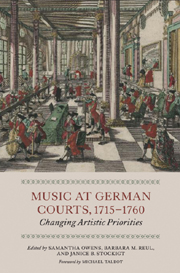Book contents
- Frontmatter
- Contents
- List of Tables
- Foreword
- Preface
- Editorial Notes
- Notes on Contributors
- List of Abbreviations
- 1 ‘Das gantze Corpus derer musicirenden Personen’: An Introduction to German Hofkapellen
- KINGDOMS AND ELECTORATES
- 2 The Court of Saxony-Dresden
- 3 The Saxon Court of the Kingdom of Poland
- 4 The Court of Brandenburg-Prussia
- 5 The Palatine Court in Mannheim
- DUCHIES
- PRINCIPALITIES AND PRINCE-BISHOPRICS
- LANDGRAVIATES AND MARGRAVIATES
- Index
5 - The Palatine Court in Mannheim
from KINGDOMS AND ELECTORATES
Published online by Cambridge University Press: 12 September 2012
- Frontmatter
- Contents
- List of Tables
- Foreword
- Preface
- Editorial Notes
- Notes on Contributors
- List of Abbreviations
- 1 ‘Das gantze Corpus derer musicirenden Personen’: An Introduction to German Hofkapellen
- KINGDOMS AND ELECTORATES
- 2 The Court of Saxony-Dresden
- 3 The Saxon Court of the Kingdom of Poland
- 4 The Court of Brandenburg-Prussia
- 5 The Palatine Court in Mannheim
- DUCHIES
- PRINCIPALITIES AND PRINCE-BISHOPRICS
- LANDGRAVIATES AND MARGRAVIATES
- Index
Summary
THE RELOCATION OF THE PALATINE COURT by Elector Carl Philipp (1661–1742, r. from 1716) from Heidelberg to Mannheim, in 1720, marked the beginning of courtly musical life for the new residential town. It was, however, during the reign of his successor, the music-loving Elector Carl Theodor (1724–1799, r. from 1743), that between the years 1747 and 1778 a Hofkapelle of a unique character developed. To this day, it is identified internationally as the ‘Mannheim School’. As this chapter will show, this Hofkapelle was not the result of an amalgamation of the Innsbruck and Düsseldorf Hofkapellen, as is commonly assumed, but, in fact, a new creation that began in 1747. Thanks to the elector's generous support, which, in addition to reasons of prestige, was clearly shaped by his own serious interest in music, the residential town of Mannheim advanced to become one of the leading musical centres of Europe during the second half of the eighteenth century.
THE HOFKAPELLE UNDER ELECTOR CARL PHILIPP (1720–42)
Before Carl Philipp succeeded his brother, the Düsseldorf-based Elector Johann Wilhelm of the Palatinate (1658–1716, r. from 1685), he maintained his own Hofkapelle – initially at his court in Breslau and then as Governor of Tirol in Innsbruck – which was amalgamated with his brother's Düsseldorf Hofkapelle following the latter's death in 1716. The negotiations were drawn out until the final takeover in 1718.
- Type
- Chapter
- Information
- Music at German Courts, 1715–1760Changing Artistic Priorities, pp. 131 - 162Publisher: Boydell & BrewerPrint publication year: 2011



